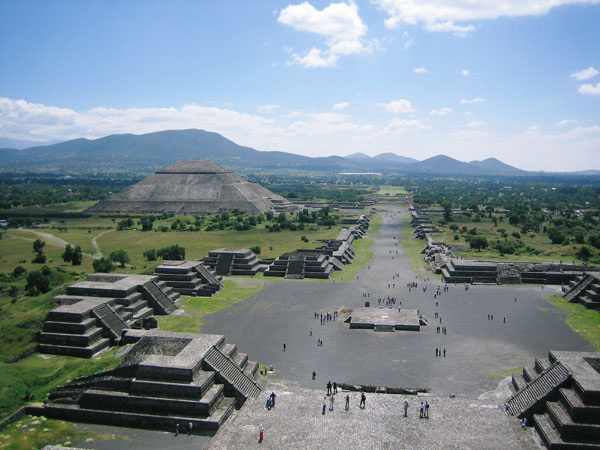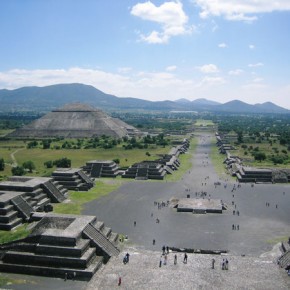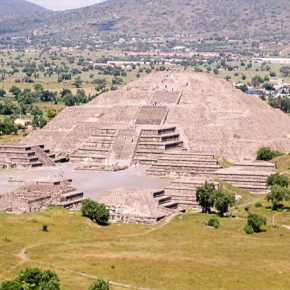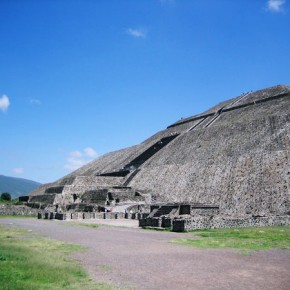Teotihuacan is an enormous archaeological site in the Basin of Mexico, containing some of the largest pyramid structures built in the pre-Colombian Americas. Apart from the pyramids, the archaeological site of Teotihuacan is also known for its large residential complexes, the so-called calle de los muertos (street of the dead), and its colorful well-preserved murals.
Teotihuacan was, at its peak in the first half of the first millennium CE, the largest city in the pre-Colombian Americas. During this time it may have had more than 100,000 inhabitants placing it among the largest cities of the world in this period. The civilization and cultural complex associated with the site is also referred to as Teotihuacan. Although it is a subject of debate whether Teotihuacan was the center of an empire, its influence throughout Mesoamerica is well documented; evidence of their presence, as well as political and economic control, can be seen at numerous sites in Veracruz and the Maya region. The ethnicity of the inhabitants of Teotihuacan is also a subject of debate and possible candidates are the Nahua, Otomi or Totonac ethnic groups. Often it has been suggested that Teotihuacan was in fact a multiethnic state.
The early history of Teotihuacan is quite mysterious, and the origin of its founders is debated. For many years, archaeologists believed it was built by the Toltec. This belief was based on colonial period texts such as the Florentine Codex which attributed the site to the Toltecs. However, the Nahuatl word Toltec, taken from the word toltecatl, means craftsman, and may not always refer to the archaeological Toltec civilization centered at Tula, Hidalgo. Since Toltec civilization flourished centuries after Teotihuacan, it seems strange they should be thought of as the city’s founders.
In the Late Formative period, a number of urban centers arose in central Mexico. The most prominent of these appears to have been Cuicuilco, on the southern shore of Lake Texcoco. Scholars have speculated that the eruption of the Xitle volcano may have prompted a mass emigration out of the central valley and into the Teotihuacan valley. These settlers may have founded and/or accelerated the growth of Teotihuacan.
Other scholars have put forth the Totonac people as the founders of Teotihuacan, and the debate continues to this day. There is evidence that at least some of the people living in Teotihuacan came from areas influenced by the Teotihuacan civilization, including the Zapotec, Mixtec and Maya peoples. The culture and architecture of Teotihuacan was influenced by the Olmec people, who are considered to be the mother civilization of Mesoamerica. The earliest buildings at Teotihuacan date to about 200 BCE, and the largest pyramid, the Pyramid of the Sun, was completed by 100 CE.
Teotihuacán was conquered by northern tribes in 700 AD and began to rapidly decline in its influence over the Mexican peoples. For two hundred years following the decline of Teotihuacán, the region had no centralized culture or political control. Beginning around 950, a culture based in northern Mexico at Tula began to dominate Central America. These people were known as the Toltecs. They were a war-like people and expanded rapidly throughout Mexico, Guatemala, and the yucatán peninsula. At the top of their society was a warrior aristocracy which attained mythical proportions in the eyes of Central Americans long after the demise of their power. Around 1200, their dominance over the region faded.
They were important as transmitters of the culture of Teotihuacán, including religion, architecture, and social structure. Their name, in fact, is not a tribal name (the original Toltec tribal names have been lost to us); the word, toltecatl, means craftsman in the Nahua languages. Toltec was simply the word used to distinguish the Mexican peoples which retained the culture and much of the urban characteristics of the culture of Teotihuacán from other peoples; even the Aztecs primarily referred to themselves by either their tribal name (Tenochca) or as Toltecs.
The Toltecs expanded the cult of Quetzalcoatl, the Sovereign Plumed Serpent, and created a mythology around the figure. In Toltec legend, Quetzalcoatl was the creator of humanity and a warrior-god that had been driven from Tula, but would return some day. The Toltecs also originated the Central American ball- game, which was played on a large stone court with a rubber ball. The game was primarily a religious ritual celebrating the victory of god-heroes over the gods of death; as a religious ritual, it involved the human sacrifice of the loser.
The Toltecs conquered large areas controlled by the Maya and settled in these areas; they migrated as far south as the Yucatán peninsula. The culture that formed out of this fusion is called the ltec-Maya, and its greatest center was Chichén Itzá— on the very tip of the Yucatan peninsula. Chichén Itzá was the last great center of Mayan civilization. The Toltec-Maya cultures greatly expanded the cultural diffusion of Mayan thought, religion, and art north into the Valley of Mexico.
- Calle de Los Muertos, Teotihuacan. Photo by Elaine Smith.
- Pyramid of the Moon, Teotihuacan. Photo by Elaine Smith.
- Pyramid of the Sun, Teotihuacan. Photo by Elaine Smith.







